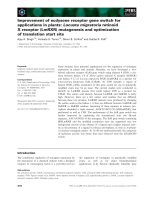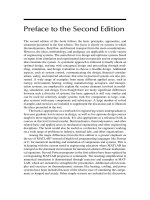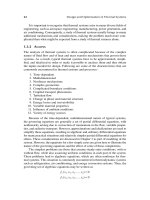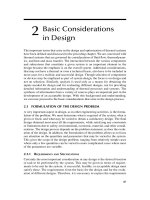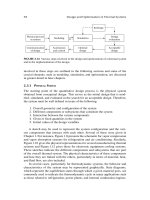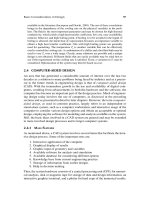design and optimization of thermal systems 66 pptx
Bạn đang xem bản rút gọn của tài liệu. Xem và tải ngay bản đầy đủ của tài liệu tại đây (5.19 MB, 753 trang )
'HVLJQDQG2SWLPL]DWLRQ
RI7KHUPDO6\VWHPV
6HFRQG(GLWLRQ
MECHANICAL ENGINEERING
A Series of Textbooks and Reference Books
Founding Editor
L. L. Faulkner
Columbus Division, Battelle Memorial Institute
and Department of Mechanical Engineering
The Ohio State University
Columbus, Ohio
1. Spring Designer’s Handbook, Harold Carlson
2. Computer-Aided Graphics and Design, Daniel L. Ryan
3. Lubrication Fundamentals, J. George Wills
4. Solar Engineering for Domestic Buildings, William A. Himmelman
5. Applied Engineering Mechanics: Statics and Dynamics, G. Boothroyd
and C. Poli
6. Centrifugal Pump Clinic, Igor J. Karassik
7. Computer-Aided Kinetics for Machine Design, Daniel L. Ryan
8. Plastics Products Design Handbook, Part A: Materials
and Components; Part B: Processes and Design for Processes,
edited by Edward Miller
9. Turbomachinery: Basic Theory and Applications, Earl Logan, Jr.
10. Vibrations of Shells and Plates, Werner Soedel
11. Flat and Corrugated Diaphragm Design Handbook, Mario Di Giovanni
12. Practical Stress Analysis in Engineering Design, Alexander Blake
13. An Introduction to the Design and Behavior of Bolted Joints,
John H. Bickford
14. Optimal Engineering Design: Principles and Applications,
James N. Siddall
15. Spring Manufacturing Handbook, Harold Carlson
16. Industrial Noise Control: Fundamentals and Applications, edited by
Lewis H. Bell
17. Gears and Their Vibration: A Basic Approach to Understanding Gear
Noise, J. Derek Smith
18. Chains for Power Transmission and Material Handling: Design
and Applications Handbook, American Chain Association
19. Corrosion and Corrosion Protection Handbook, edited by
Philip A. Schweitzer
20. Gear Drive Systems: Design and Application, Peter Lynwander
21. Controlling In-Plant Airborne Contaminants: Systems Design
and Calculations, John D. Constance
22. CAD/CAM Systems Planning and Implementation, Charles S. Knox
23. Probabilistic Engineering Design: Principles and Applications,
James N. Siddall
24. Traction Drives: Selection and Application, Frederick W. Heilich III
and Eugene E. Shube
25. Finite Element Methods: An Introduction, Ronald L. Huston
and Chris E. Passerello
26. Mechanical Fastening of Plastics: An Engineering Handbook,
Brayton Lincoln, Kenneth J. Gomes, and James F. Braden
27. Lubrication in Practice: Second Edition, edited by W. S. Robertson
28. Principles of Automated Drafting, Daniel L. Ryan
29. Practical Seal Design, edited by Leonard J. Martini
30. Engineering Documentation for CAD/CAM Applications,
Charles S. Knox
31. Design Dimensioning with Computer Graphics Applications,
Jerome C. Lange
32. Mechanism Analysis: Simplified Graphical and Analytical Techniques,
Lyndon O. Barton
33. CAD/CAM Systems: Justification, Implementation, Productivity
Measurement, Edward J. Preston, George W. Crawford,
and Mark E. Coticchia
34. Steam Plant Calculations Manual, V. Ganapathy
35. Design Assurance for Engineers and Managers, John A. Burgess
36. Heat Transfer Fluids and Systems for Process and Energy
Applications, Jasbir Singh
37. Potential Flows: Computer Graphic Solutions, Robert H. Kirchhoff
38. Computer-Aided Graphics and Design: Second Edition,
Daniel L. Ryan
39. Electronically Controlled Proportional Valves: Selection
and Application, Michael J. Tonyan, edited by Tobi Goldoftas
40. Pressure Gauge Handbook, AMETEK, U.S. Gauge Division, edited b
y
Philip W. Harland
41. Fabric Filtration for Combustion Sources: Fundamentals and Basic
Technology, R. P. Donovan
42. Design of Mechanical Joints, Alexander Blake
43. CAD/CAM Dictionary, Edward J. Preston, George W. Crawford,
and Mark E. Coticchia
44. Machinery Adhesives for Locking, Retaining, and Sealing,
Girard S. Haviland
45. Couplings and Joints: Design, Selection, and Application,
Jon R. Mancuso
46. Shaft Alignment Handbook, John Piotrowski
47. BASIC Programs for Steam Plant Engineers: Boilers, Combustion,
Fluid Flow, and Heat Transfer, V. Ganapathy
48. Solving Mechanical Design Problems with Computer Graphics,
Jerome C. Lange
49. Plastics Gearing: Selection and Application, Clifford E. Adams
50. Clutches and Brakes: Design and Selection, William C. Orthwein
51. Transducers in Mechanical and Electronic Design
, Harry L. Trietley
52. Metallurgical Applications of Shock-Wave and High-Strain-Rate
Phenomena, edited by Lawrence E. Murr, Karl P. Staudhammer,
and Marc A. Meyers
53. Magnesium Products Design, Robert S. Busk
54. How to Integrate CAD/CAM Systems: Management and Technology,
William D. Engelke
55. Cam Design and Manufacture: Second Edition; with cam design
software for the IBM PC and compatibles, disk included,
Preben W. Jensen
56. Solid-State AC Motor Controls: Selection and Application,
Sylvester Campbell
57. Fundamentals of Robotics, David D. Ardayfio
58. Belt Selection and Application for Engineers, edited by
Wallace D. Erickson
59. Developing Three-Dimensional CAD Software with the IBM PC,
C. Stan Wei
60. Organizing Data for CIM Applications, Charles S. Knox, with
contributions by Thomas C. Boos, Ross S. Culverhouse,
and Paul F. Muchnicki
61. Computer-Aided Simulation in Railway Dynamics, by Rao V. Dukkipati
and Joseph R. Amyot
62. Fiber-Reinforced Composites: Materials, Manufacturing, and Design,
P. K. Mallick
63. Photoelectric Sensors and Controls: Selection and Application,
Scott M. Juds
64. Finite Element Analysis with Personal Computers,
Edward R. Champion, Jr. and J. Michael Ensminger
65. Ultrasonics: Fundamentals, Technology, Applications: Second Edition,
Revised and Expanded, Dale Ensminger
66. Applied Finite Element Modeling: Practical Problem Solving
for Engineers, Jeffrey M. Steele
67. Measurement and Instrumentation in Engineering: Principles
and Basic Laboratory Experiments, Francis S. Tse and Ivan E. Morse
68. Centrifugal Pump Clinic: Second Edition, Revised and Expanded,
Igor J. Karassik
69. Practical Stress Analysis in Engineering Design: Second Edition,
Revised and Expanded, Alexander Blake
70. An Introduction to the Design and Behavior of Bolted Joints:
Second Edition, Revised and Expanded, John H. Bickford
71. High Vacuum Technology: A Practical Guide, Marsbed H. Hablanian
72. Pressure Sensors: Selection and Application, Duane Tandeske
73. Zinc Handbook: Properties, Processing, and Use in Design,
Frank Porter
74. Thermal Fatigue of Metals, Andrzej Weronski and Tadeusz Hejwowski
75. Classical and Modern Mechanisms for Engineers and Inventors,
Preben W. Jensen
76. Handbook of Electronic Package Design, edited by Michael Pecht
77. Shock-Wave and High-Strain-Rate Phenomena in Materials, edited by
Marc A. Meyers, Lawrence E. Murr, and Karl P. Staudhammer
78. Industrial Refrigeration: Principles, Design and Applications,
P. C. Koelet
79. Applied Combustion, Eugene L. Keating
80. Engine Oils and Automotive Lubrication
, edited by Wilfried J. Bartz
81. Mechanism Analysis: Simplified and Graphical Techniques, Second
Edition, Revised and Expanded, Lyndon O. Barton
82. Fundamental Fluid Mechanics for the Practicing Engineer,
James W. Murdock
83. Fiber-Reinforced Composites: Materials, Manufacturing, and Design,
Second Edition, Revised and Expanded, P. K. Mallick
84. Numerical Methods for Engineering Applications,
Edward R. Champion, Jr.
85. Turbomachinery: Basic Theory and Applications, Second Edition,
Revised and Expanded, Earl Logan, Jr.
86. Vibrations of Shells and Plates: Second Edition, Revised
and Expanded, Werner Soedel
87. Steam Plant Calculations Manual: Second Edition, Revised
and Expanded, V. Ganapathy
88. Industrial Noise Control: Fundamentals and Applications, Second
Edition, Revised and Expanded, Lewis H. Bell and Douglas H. Bell
89. Finite Elements: Their Design and Performance, Richard H. MacNeal
90. Mechanical Properties of Polymers and Composites: Second Edition,
Revised and Expanded, Lawrence E. Nielsen and Robert F. Landel
91. Mechanical Wear Prediction and Prevention, Raymond G. Bayer
92. Mechanical Power Transmission Components, edited by
David W. South and Jon R. Mancuso
93. Handbook of Turbomachinery, edited by Earl Logan, Jr.
94. Engineering Documentation Control Practices and Procedures,
Ray E. Monahan
95. Refractory Linings Thermomechanical Design and Applications,
Charles A. Schacht
96. Geometric Dimensioning and Tolerancing: Applications
and Techniques for Use in Design, Manufacturing, and Inspection,
James D. Meadows
97. An Introduction to the Design and Behavior of Bolted Joints:
Third Edition, Revised and Expanded, John H. Bickford
98. Shaft Alignment Handbook: Second Edition, Revised and Expanded,
John Piotrowski
99. Computer-Aided Design of Polymer-Matrix Composite Structures,
edited by Suong Van Hoa
100. Friction Science and Technology, Peter J. Blau
101. Introduction to Plastics and Composites: Mechanical Properties
and Engineering Applications, Edward Miller
102. Practical Fracture Mechanics in Design, Alexander Blake
103. Pump Characteristics and Applications, Michael W. Volk
104. Optical Principles and Technology for Engineers, James E. Stewart
105. Optimizing the Shape of Mechanical Elements and Structures,
A. A. Seireg and Jorge Rodriguez
106. Kinematics and Dynamics of Machinery, Vladimír Stejskal
and Michael Valásek
107. Shaft Seals for Dynamic Applications, Les Horve
108. Reliability-Based Mechanical Design, edited by Thomas A. Cruse
109. Mechanical Fastening, Joining, and Assembly, James A. Speck
110. Turbomachinery Fluid Dynamics and Heat Transfer, edited by
Chunill Hah
111. High-Vacuum Technology: A Practical Guide, Second Edition,
Revised and Expanded, Marsbed H. Hablanian
112. Geometric Dimensioning and Tolerancing: Workbook
and Answerbook, James D. Meadows
113. Handbook of Materials Selection for Engineering Applications,
edited by G. T. Murray
114. Handbook of Thermoplastic Piping System Design, Thomas Sixsmith
and Reinhard Hanselka
115. Practical Guide to Finite Elements: A Solid Mechanics Approach,
Steven M. Lepi
116. Applied Computational Fluid Dynamics, edited by Vijay K. Garg
117. Fluid Sealing Technology, Heinz K. Muller and Bernard S. Nau
118. Friction and Lubrication in Mechanical Design, A. A. Seireg
119. Influence Functions and Matrices, Yuri A. Melnikov
120. Mechanical Analysis of Electronic Packaging Systems,
Stephen A. McKeown
121. Couplings and Joints: Design, Selection, and Application, Second
Edition, Revised and Expanded, Jon R. Mancuso
122. Thermodynamics: Processes and Applications, Earl Logan, Jr.
123. Gear Noise and Vibration, J. Derek Smith
124. Practical Fluid Mechanics for Engineering Applications,
John J. Bloomer
125. Handbook of Hydraulic Fluid Technology, edited by George E. Totten
126. Heat Exchanger Design Handbook, T. Kuppan
127. Designing for Product Sound Quality, Richard H. Lyon
128. Probability Applications in Mechanical Design, Franklin E. Fisher
and Joy R. Fisher
129. Nickel Alloys, edited by Ulrich Heubner
130. Rotating Machinery Vibration: Problem Analysis and Troubleshooting,
Maurice L. Adams, Jr.
131. Formulas for Dynamic Analysis, Ronald L. Huston and C. Q. Liu
132. Handbook of Machinery Dynamics, Lynn L. Faulkner
and Earl Logan, Jr.
133. Rapid Prototyping Technology: Selection and Application,
Kenneth G. Cooper
134. Reciprocating Machinery Dynamics: Design and Analysis,
Abdulla S. Rangwala
135. Maintenance Excellence: Optimizing Equipment Life-Cycle Decisions,
edited by John D. Campbell and Andrew K. S. Jardine
136. Practical Guide to Industrial Boiler Systems, Ralph L. Vandagriff
137. Lubrication Fundamentals: Second Edition, Revised and Expanded,
D. M. Pirro and A. A. Wessol
138. Mechanical Life Cycle Handbook: Good Environmental Design
and Manufacturing, edited by Mahendra S. Hundal
139. Micromachining of Engineering Materials, edited by
Joseph McGeough
140. Control Strategies for Dynamic Systems: Design and Implementation,
John H. Lumkes, Jr.
141. Practical Guide to Pressure Vessel Manufacturing, Sunil Pullarcot
142. Nondestructive Evaluation: Theory, Techniques, and Applications,
edited by Peter J. Shull
143. Diesel Engine Engineering: Thermodynamics, Dynamics, Design,
and Control, Andrei Makartchouk
144. Handbook of Machine Tool Analysis, Ioan D. Marinescu,
Constantin Ispas, and Dan Boboc
145. Implementing Concurrent Engineering in Small Companies,
Susan Carlson Skalak
146. Practical Guide to the Packaging of Electronics: Thermal
and Mechanical Design and Analysis, Ali Jamnia
147. Bearing Design in Machinery: Engineering Tribology and Lubrication,
Avraham Harnoy
148. Mechanical Reliability Improvement: Probability and Statistics
for Experimental Testing, R. E. Little
149. Industrial Boilers and Heat Recovery Steam Generators: Design,
Applications, and Calculations, V. Ganapathy
150. The CAD Guidebook: A Basic Manual for Understanding
and Improving Computer-Aided Design, Stephen J. Schoonmaker
151. Industrial Noise Control and Acoustics, Randall F. Barron
152. Mechanical Properties of Engineered Materials, Wolé Soboyejo
153. Reliability Verification, Testing, and Analysis in Engineering Design,
Gary S. Wasserman
154. Fundamental Mechanics of Fluids: Third Edition, I. G. Currie
155. Intermediate Heat Transfer, Kau-Fui Vincent Wong
156. HVAC Water Chillers and Cooling Towers: Fundamentals, Application,
and Operation, Herbert W. Stanford III
157. Gear Noise and Vibration: Second Edition, Revised and Expanded,
J. Derek Smith
158. Handbook of Turbomachinery: Second Edition, Revised
and Expanded, edited by Earl Logan, Jr. and Ramendra Roy
159. Piping and Pipeline Engineering: Design, Construction, Maintenance,
Integrity, and Repair, George A. Antaki
160. Turbomachinery: Design and Theory, Rama S. R. Gorla
and Aijaz Ahmed Khan
161. Target Costing: Market-Driven Product Design, M. Bradford Clifton,
Henry M. B. Bird, Robert E. Albano, and Wesley P. Townsend
162. Fluidized Bed Combustion, Simeon N. Oka
163. Theory of Dimensioning: An Introduction to Parameterizing Geometric
Models, Vijay Srinivasan
164. Handbook of Mechanical Alloy Design, edited by George E. Totten,
Lin Xie, and Kiyoshi Funatani
165. Structural Analysis of Polymeric Composite Materials, Mark E. Tuttle
166. Modeling and Simulation for Material Selection and Mechanical
Design, edited by George E. Totten, Lin Xie, and Kiyoshi Funatani
167. Handbook of Pneumatic Conveying Engineering
, David Mills,
Mark G. Jones, and Vijay K. Agarwal
168. Clutches and Brakes: Design and Selection, Second Edition,
William C. Orthwein
169. Fundamentals of Fluid Film Lubrication: Second Edition,
Bernard J. Hamrock, Steven R. Schmid, and Bo O. Jacobson
170. Handbook of Lead-Free Solder Technology for Microelectronic
Assemblies, edited by Karl J. Puttlitz and Kathleen A. Stalter
171. Vehicle Stability, Dean Karnopp
172. Mechanical Wear Fundamentals and Testing: Second Edition,
Revised and Expanded, Raymond G. Bayer
173. Liquid Pipeline Hydraulics, E. Shashi Menon
174. Solid Fuels Combustion and Gasification, Marcio L. de Souza-Santos
175. Mechanical Tolerance Stackup and Analysis, Bryan R. Fischer
176. Engineering Design for Wear, Raymond G. Bayer
177. Vibrations of Shells and Plates: Third Edition, Revised and Expanded,
Werner Soedel
178. Refractories Handbook, edited by Charles A. Schacht
179. Practical Engineering Failure Analysis, Hani M. Tawancy,
Anwar Ul-Hamid, and Nureddin M. Abbas
180. Mechanical Alloying and Milling, C. Suryanarayana
181. Mechanical Vibration: Analysis, Uncertainties, and Control, Second
Edition, Revised and Expanded, Haym Benaroya
182. Design of Automatic Machinery, Stephen J. Derby
183. Practical Fracture Mechanics in Design: Second Edition, Revised
and Expanded, Arun Shukla
184. Practical Guide to Designed Experiments, Paul D. Funkenbusch
185. Gigacycle Fatigue in Mechanical Practive, Claude Bathias
and Paul C. Paris
186. Selection of Engineering Materials and Adhesives,
Lawrence W. Fisher
187. Boundary Methods: Elements, Contours, and Nodes,
Subrata Mukherjee and Yu Xie Mukherjee
188. Rotordynamics, Agnieszka (Agnes) Muszn´yska
189. Pump Characteristics and Applications: Second Edition,
Michael W. Volk
190. Reliability Engineering: Probability Models and Maintenance Methods,
Joel A. Nachlas
191. Industrial Heating: Principles, Techniques, Materials, Applications,
and Design, Yeshvant V. Deshmukh
192. Micro Electro Mechanical System Design, James J. Allen
193. Probability Models in Engineering and Science, Haym Benaroya
and Seon Han
194. Damage Mechanics, George Z. Voyiadjis and Peter I. Kattan
195. Standard Handbook of Chains: Chains for Power Transmission
and Material Handling, Second Edition, American Chain Association
and John L. Wright, Technical Consultant
196. Standards for Engineering Design and Manufacturing,
Wasim Ahmed Khan and Abdul Raouf S.I.
197. Maintenance, Replacement, and Reliability: Theory and Applications,
Andrew K. S. Jardine and Albert H. C. Tsang
198. Finite Element Method: Applications in Solids, Structures, and Heat
Transfer, Michael R. Gosz
199. Microengineering, MEMS, and Interfacing: A Practical Guide,
Danny Banks
200. Fundamentals of Natural Gas Processing, Arthur J. Kidnay
and William Parrish
201. Optimal Control of Induction Heating Processes, Edgar Rapoport
and Yulia Pleshivtseva
202. Practical Plant Failure Analysis: A Guide to Understanding Machinery
Deterioration and Improving Equipment Reliability,
Neville W. Sachs, P.E.
203. Shaft Alignment Handbook, Third Edition, John Piotrowski
204. Advanced Vibration Analysis , S. Graham Kelly
205. Principles of Composite Materials Mechanics, Second Edition,
Ronald F. Gibson
206. Applied Combustion, Second Edition, Eugene L. Keating
207. Introduction to the Design and Behavior of Bolted Joints,
Fourth Edition: Non-Gasketed Joints, John H. Bickford
208. Analytical and Approximate Methods in Transport Phenomena,
Marcio L. de Souza-Santos
209. Design and Optimization of Thermal Systems, Second Edition,
Yogesh Jaluria
CRC Press is an imprint of the
Taylor & Francis Group, an informa business
Boca Raton London New York
'HVLJQDQG2SWLPL]DWLRQ
RI7KHUPDO6\VWHPV
6HFRQG(GLWLRQ
<RJHVK-DOXULD
CRC Press
Taylor & Francis Group
6000 Broken Sound Parkway NW, Suite 300
Boca Raton, FL 33487-2742
© 2008 by Taylor & Francis Group, LLC
CRC Press is an imprint of Taylor & Francis Group, an Informa business
No claim to original U.S. Government works
Printed in the United States of America on acid-free paper
10 9 8 7 6 5 4 3 2 1
International Standard Book Number-13: 978-0-8493-3753-6 (Hardcover)
This book contains information obtained from authentic and highly regarded sources. Reprinted material
is quoted with permission, and sources are indicated. A wide variety of references are listed. Reasonable
efforts have been made to publish reliable data and information, but the author and the publisher cannot
assume responsibility for the validity of all materials or for the consequences of their use.
Except as permitted under U.S. Copyright Law, no part of this book may be reprinted, reproduced, trans-
mitted, or utilized in any form by any electronic, mechanical, or other means, now known or hereafter
invented, including photocopying, microfilming, and recording, or in any information storage or retrieval
system, without written permission from the publishers.
For permission to photocopy or use material electronically from this work, please access www.copyright.
com ( or contact the Copyright Clearance Center, Inc. (CCC) 222 Rosewood
Drive, Danvers, MA 01923, 978-750-8400. CCC is a not-for-profit organization that provides licenses and
registration for a variety of users. For organizations that have been granted a photocopy license by the
CCC, a separate system of payment has been arranged.
Trademark Notice: Product or corporate names may be trademarks or registered trademarks, and are
used only for identification and explanation without intent to infringe.
Library of Congress Cataloging-in-Publication Data
Jaluria, Yogesh.
Design and optimization of thermal systems / Yogesh Jaluria. 2nd ed.
p. cm. (Mechanical engineering)
Includes bibliographical references and index.
ISBN 978-0-8493-3753-6 (alk. paper)
1. Heat engineering. 2. Engineering design. I. Title. II. Series.
TJ260.J353 2007
621.402 dc22 2007027214
Visit the Taylor & Francis Web site at
and the CRC Press Web site at
MATLAB® is a trademark of The MathWorks, Inc. and is used with permission. The MathWorks does
not warrant the accuracy of the text or exercises in this book. This book’s use or discussion of MATLAB®
software or related products does not constitute endorsement or sponsorship by The MathWorks of a
particular pedagogical approach or particular use of the MATLAB® software.
Contents
Chapter 1 Introduction 1
1.1 Engineering Design 2
1.1.1 Design Versus Analysis 2
1.1.2 Synthesis for Design 6
1.1.3 Selection Versus Design 7
1.2 D esign as Par t of Engineering Enter prise 9
1.2.1 Need or Oppor tun ity 9
1.2.2 Evaluation and Market Analysis 10
1.2.3 Feasibility and Chances of Success 12
1.2.4 Engineering Design 14
1.2.5 Research a nd Development 15
1.2.6 Need for Optimization 16
1.2.7 Fabrication, Testing, and Production 18
1.3 Thermal Systems 19
1.3.1 Basic Cha r acter istics 19
1.3.2 Analysis 22
1.3.3 Types and Examples 25
1.4 Outline and Scope of the Book 40
1.5 Summary 43
References 44
Chapter 2 Basic Considerations i n Design 47
2.1 Formulation of the Design Problem 47
2.1.1 Requirements and Specications 47
2.1.2 Given Quantities 50
2.1.3 Design Variables 51
2.1.4 Constraints or Limitations 53
2.1.5 Additional Considerations 55
2.2 Conceptual Design 58
2.2.1 Innovative Conceptual Design 58
2.2 .2 Selection f rom Avai lable Concepts 62
2.2.3 Modications in the Design of Existing Systems 64
2.3 Steps in the Design Process 70
2.3.1 Physical System 72
2.3.2 Modeling 75
2.3.3 Simulation 76
2.3.4 Evaluation: Acceptable Design 81
2.3.5 Optimal Design 83
2.3.6 Safety Features, Automation, and Control 86
2.3.7 Communicating the Design 90
2.3.8 Patents and Copyrights 92
2.4 Computer-Aided Design 97
2.4.1 Main Features 97
2.4.2 Computer-Aided Design of Thermal Systems 98
2.5 Material Selection 104
2.5.1 Different Materials 104
2.5.2 MaterialPropertiesandCharacteristics
for Thermal Systems 108
2.5.3 Selection and Substitution of Materials 110
2.6 Summary 113
References 115
Problems 116
Chapter 3 Modeling of Thermal Systems 125
3.1 Introduction 125
3.1.1 Importance of Modeling in Design 125
3.1.2 Basic Features of Modeling 125
3.2 Types of Models 128
3.2.1 Ana log Models 129
3.2.2 Mathematical Models 130
3.2.3 Physical Models 130
3.2.4 Numerica l Models 131
3.2.5 Interaction Between Models 133
3.2.6 Other Classications 133
3.3 Mathematical Modeling 134
3.3.1 General Procedure 134
3.3.2 Final Model and Validation 160
3.4 Physical Modeling and Dimensional Ana lysis 165
3.4.1 Dimensional Analysis 166
3.4.2 Modeling and Similitude 176
3.4.3 Overal l Physical Model 180
3.5 Curve Fitting 180
3.5.1 Exact Fit 181
3.5.2 Best Fit 183
3.6 Summary 194
References 196
Problems 197
Chapter 4 Numerical Modeling and Simulation 207
4.1 Numerical Modeling 208
4.1.1 General Features 208
4.1.2 Development of a Numerical Model 210
4.1.3 Available Software 211
4.2 Solution Procedures 212
4.2.1 Linear Algebraic Systems 213
4.2.2 Nonlinear Algebraic Systems 220
4.2.3 Ordina r y Di fferentia l Equat ions 227
4.2.4 Par tial Differential Equations 238
4.3 Numerica l Model for a System 247
4.3.1 Modeling of Individual Components 248
4.3.2 Merging of Different Models 251
4.3.3 Accuracy and Val idat ion 252
4.4 System Simulation 253
4.4.1 Importance of Simulation 254
4.4.2 Dif ferent Classes 256
4.4.3 Flow of Information 259
4.5 Method s for Numer ical Simulation 264
4.5.1 Steady Lumped Systems 264
4.5.2 Dynamic Simulation of Lumped Systems 272
4.5.3 Distributed Systems 278
4.5.4 Simulation of Large Systems 282
4.5.5 Numerical Simulation Versus Real System 283
4.6 Summary 284
References 285
Problems 286
Chapter 5 Acceptable Design of a Thermal System:
A Synthesis of D ifferent Design Steps 299
5.1 Introduction 299
5.2 Initial Design 300
5.3 Design Strategies 309
5.3.1 Commonly Used Design Approach 309
5.3.2 Other Strategies 309
5.3.3 Iterative Redesign Procedure 317
5.4 Design of Systems from Different Application Areas 322
5.4.1 Manufact ur ing P rocesses 323
5.4.2 Cooling of Electronic Equipment 329
5.4.3 Environmental Systems 336
5.4.4 Heat Transfer Equipment 342
5.4.5 F luid Flow Systems 350
5.4.6 Other A reas 361
5.4.7 Design of Components Versus Design of Systems 361
5.5 Additional Considerations for Large Practical Systems 362
5.6 Summary 373
References 374
Problems 375
Chapter 6 Econom ic Considerations 383
6.1 Introduction 383
6.2 Calculation of Interest 385
6.2.1 Simple Interest 385
6.2.2 Compound I nterest 385
6.2.3 Continuous Compounding 387
6.2.4 Effective Interest Rate 388
6.3 Worth of Money as a Function of Time 390
6.3.1 Present Worth 390
6.3.2 Future Wor th 391
6.3.3 Ination 393
6.4 Series of Payments 396
6.4.1 Futu re Worth of Uniform Series of A mounts 396
6.4.2 Present Worth of Uniform Series of Amounts 397
6.4.3 Continuous Compounding in a Series of Amounts 399
6.4.4 Changing Amount in Series of Payments 400
6.4.5 Shift in Time 402
6.4.6 Different Frequencies 403
6.4.7 Changes in Schedule 403
6.5 Raising Capital 405
6.5.1 Bonds 406
6.5.2 Stocks 408
6.6 Taxes 408
6.6.1 Inclusion of Taxes 409
6.6.2 Depreciation 410
6.7 Economic Factor in Design 413
6.7.1 Cost Comparison 413
6.7.2 Rate of Retur n 417
6.8 Application to Thermal Systems 419
6.9 Summary 421
References 421
Problems 422
Chapter 7 Problem Formulation for Optimization 429
7.1 Introduction 429
7.1.1 Optimizat ion i n Design 429
7.1.2 Final Optimized Design 431
7.2 Basic Concepts 432
7.2.1 Objective Function 432
7.2.2 Constraints 434
7.2.3 Operating Conditions Versus Hardware 437
7.2.4 Mathematical Formulation 438
7.3 Optimization Methods 440
7.3.1 Calculus Methods 440
7.3.2 Search Methods 441
7.3.3 Li nea r a nd Dy na mic P rogr am m i ng 442
7.3.4 Geometric Programming 444
7.3.5 Other Methods 444
7.4 Optimization of Thermal Systems 447
7.4.1 Important Considerations 447
7.4.2 Di fferent Approaches 448
7.4.3 Different Types of Thermal Systems 449
7.4.4 Exa mples 451
7.4.5 Consideration of the Second Law of Thermodynamics 455
7.5 Practical Aspects in Optimal Design 457
7.5.1 Choice of Va riables for Optimization 457
7.5.2 Sensitivity Analysis 459
7.5.3 Dependence on Objective Function: Trade-Offs 461
7.5.4 Multi-Objective Optimization 462
7. 5.5 Par t of Overall Design Strategy 464
7.5.6 Change of Concept or Model 465
7.6 Summary 466
References 467
Problems 468
Chapter 8 Lagrange Multipliers 473
8.1 Introduction to Calculus Methods 473
8.2 The Lagra nge Multiplier Method 475
8.2.1 Basic Approach 475
8.2.2 Physical Interpretation 477
8.2.3 Sign icance of t he Multipliers 485
8.3 Opti mizat ion of Unconstrai ned Problems 486
8.3.1 Use of Gradients for Optimization 487
8.3.2 Determination of Minimum or Maximum 487
8.3.3 Conversion of Constrained to Unconstrained
Problem 489
8.4 Optimization of Constrained Problems 491
8.5 Applicability to Thermal Systems 494
8.5.1 Use of Curve Fitting 494
8.5.2 Examples 495
8.5.3 Inequality Constrai nts 499
8.5.4 Some Practical Considerations 500
8.5.5 Computational Approach 501
8.6 Summary 503
References 504
Problems 505
Chapter 9 Search Methods 511
9.1 Basic Considerations 511
9.1.1 Importance of Sea rch Method s 512
9.1.2 Types of Approaches 513
9.1.3 Application to Thermal Systems 514
9.2 Single-Var iable Problem 515
9.2.1 Uniform Exhaustive Search 517
9.2.2 Dichotomous Search 519
9.2.3 Fibonacci Sea rch 521
9.2.4 Golden Section a nd Other Sear ch Method s 523
9.2.5 Comparison of Different Elimination Methods 524
9.3 Unconstrained Search with Multiple Variables 527
9.3.1 Lattice Search 529
9.3.2 Univar iat e Search 530
9.3.3 Steepest Ascent/Descent Method 532
9.4 Multivariable Constrained Optimization 537
9.4.1 Penalty Fu nction Method 537
9.4.2 Search Along a Constraint 542
9.5 Examples of Ther mal Systems 547
9.6 Summary 551
References 553
Problems 554
Chapter 10 Geometric, Linear, and Dynamic Programming
and Other Met hods for Opti mi zation 559
10.1 Geometric Programming 559
10.1.1 Applicability 560
10.1.2 Unconstrai ned Opt imiz ation 561
10.1.3 Mathematical Proof 570
10.1.4 Constrained Optimization 573
10.1.5 Nonzero Degree of Difculty 578
10.2 Linear P rogra mming 579
10.3 Dynamic Progr amming 588
10.4 Ot her Met hod s 590
10.5 Summary 591
References 592
Problems 593
Chapter 11 Knowledge-Based Design and Additional Considerations 599
11.1 Knowledge-Based Systems 599
11.1.1 I nt ro duction 600
11.1.2 Basic Components 602
11.1.3 Expert Knowledge 607
11.1.4 Design Metho dology 609
11.1.5 Application to Thermal Systems 610
11.2 Additional Constraints 621
11.3 Professional Ethics 623
11.4 Sour ces of In for mat ion 625
11.5 An Overview of Design of Thermal Systems 628
11.6 Summary 631
References 632
Problems 633
Design Projects 635
Appendix A Computer Programs 639
Appendix B Material Properties 659
Appendix C Interest Tables 679
Appendix D Heat Transfer Correlations 687
Index 697
Preface to the First Edition
APPROACH
Design is an essential element in engineering education and practice. In recent
years,therehasbeenagrowingemphasisonthedesignandoptimizationofsys-
temsbecauseofgrowingworldwidecompetitionandthedevelopmentofnew
processes and techniques. Design has long been very important in undergraduate
mechanicalengineeringcurriculaaroundthecountry.However,theefforthad
been largely directed at mechanical systems, dealing with areas such as transmis-
sion, vibrations, robotics, and controls, and at components such as gears, cams,
springs, and linkages.
Withthegrowthofthermalsystems,suchasthoserelatedtomaterialspro-
cessing, energy conversion, pollution, aerospace, and automobiles, the need to
design and optimize thermal systems has also grown. In mechanical engineer-
ing programs around the country, courses have been developed on the design
of thermal systems. These are often elective courses, or, in many schools, such
courses form the nal capstone design course, often alternated with a design
course on mechanical systems. Invariably, optimization is an important element
insuchcoursesbecauseofthecrucialneedtooptimizesystemsinpractical
applications.
Thisbookiswrittenasatextbookattheseniorundergraduateortherst-year
graduatelevel.Itcanalsobeusedasareferencebookforotherthermalsciences
courses, such as those on heat transfer, uid mechanics, and thermodynamics,
and for courses in applied areas, such as power plants, environmental control of
buildings,andsolarenergysystems.Itcanbeusedforreferencebypracticing
engineersaswell.Althoughthebookiswrittenforengineeringeducationcurri-
culaintheUnitedStates,thematerialandtreatmentcaneasilybeusedinvarious
countriesaroundtheworld.Thebookislargelywrittenformechanicalengineers.
However,thematerialissuitableforcoursesinotherengineeringdisciplines,
suchaschemical,aerospace,industrial,andmaterialsengineering.
Thebookisdirectedatthedesignofthermalsystems,employingexamples
fromdiverseareassuchasmanufacturing,energysystems,coolingofelectronic
equipment, refrigeration, environmental problems, engines, and heat transfer equip-
ment.ManysuchexamplesandanintroductiontodesignaregiveninChapter1.
Then the conceptual design and formulation of the design problem are presented
in Chapter 2, along with the main constituents of design, including material selec-
tion.Thedesignprocess,aspredominantlybasedonthemathematicalmodeling
ofthesystemandontheresultsobtainedfromnumericalsimulation,ispresented
inthenextthreechapters.Analyticalresults,ifavailable,arevaluableforvalidat-
ingthenumericalmodelaswellasforprovidingafundamentalbasisfordesign.
The use of experimental data, mainly as correlations derived from curve tting, is
presented as an essential element in the design and optimization process.
The basic approach to the development of a suitable model is discussed in
Chapter3indetailsincethisformsthemostcrucialstepinthedesignofasys-
tem.Variousapproximationsandidealizationsthatcanbeusedformodelingare
presented, along with examples of mathematical modeling of practical systems.
This is followed in Chapter 4 by detailed discussions of numerical modeling and
simulation, again linking these to the mathematical model and experimental data.
Theseresultsthenformthebasisforcreativedesignofthermalsystemsandfor
theevaluationofthedesignsobtained.
The development of a workable, or acceptable, design, one which satises
the requirements and constraints of the problem, is discussed as a synthesis of the
different design steps. Several examples are given in Chapter 5 to illustrate the
overallprocedure.ThisisfollowedinChapter6byadiscussionofeconomic
factors in design since these often guide system design and optimization. The for-
mulationoftheoptimizationproblemisexplainedinChapter7.Thepresentation
on optimization includes several applicable methods such as calculus methods,
search methods, and linear, dynamic, and geometric programming. These topics
are covered in Chapter 8 through Chapter 10. Again, thermal systems found in
several important and relevant areas are used as examples to illustrate the ideas
presented. Solved examples and problems strengthen the presentation and allow
theimportantconceptstobeassimilatedbythereaders.Recenttrends,suchas
knowledge-based design methodology, are included in Chapter 11. Additional
practical considerations, such as economic, safety, and materials, are also dis-
cussedatvariousstagesofthepresentation.
Therefore,thebookstartswiththebasicdesignconceptanddevelopsthe
material through modeling and simulation stages of the thermal process and sys-
temontothecreationofaworkabledesign.Theiterativeprocessthatisoftenused
to obtain an acceptable design is presented. This logically leads to optimization
procedures and the improvement of the design to obtain the best possible solu-
tionunderthegivenconstraints.Thebookoffersasystematicapproach,explor-
ingthevariousconsiderationsthatleadtoaworkableand,nally,toanoptimal
design; uses up-to-date examples and problems, and presents the most current
information and design tools available in this important eld. Examples range
fromsimplesystemstolarge,complexpracticalsystems.Synthesisofthevarious
aspects that constitute design is discussed in detail. A few relevant computer pro-
grams are included to help with the numerical modeling and simulation. These
includeprogramsoncurvetting,solutionofalgebraicsystems,andsolutionof
simple differential equations. Quantitative information on materials, economics,
andheattransfercorrelationsisalsoincluded.Themathematicalmodelingof
systemsisaparticularlyimportantaspectofdesign,thoughitisoftenneglected.
Modeling is presented with a wide range of physical examples and a discussion of
thetypesofapproximationsthatcanbeusedtosimplifytheproblem.Theinputs
obtainedfromthemodelforaninnovativeandoptimaldesignareoutlined.
Themainthrustofthisbookistodevelopanddiscussthebasicconsider-
ations that arise in the design and optimization of thermal systems, as well as the
appropriate methodology. Readers are encouraged to use their own backgrounds,
imaginations, and available literature for designing different types of systems.
Sincesimpleclosed-form,analytical,solutionsarerarelyobtainedinpractical
thermalsystems,clearandconciseanswersarenotreadilyavailableinmany
cases.Aconsiderationofseveralpracticalsystemsmakesthisaspectofthermal
system design clear.
The material included in this book has been used in courses for undergraduate
seniorsatRutgersUniversityandattheIndianInstituteofTechnology,Kanpur,
India. The topics, examples, and problems have, therefore, been largely tested in
a classroom environment. Various design projects and examples emerged from
these courses, and some of them are included in the text. In keeping with the
basicdesignprocess,manyoftheproblemsareopen-endedandauniquesolution
is not obtained.
SUPPLEMENT
Asolutionsmanual,preparedbymeinordertoensuretheproblem-solvingmeth-
odologyisthesameasthatinthebook,isavailabletotextadopters.Thismanual
containspossiblesolutionstomostoftheproblemsinthisbook(sincemanyprob-
lemsareopen-endedandthusdonothaveauniquesolution).
ACKNOWLEDGMENTS
Many colleagues, friends, and students have contributed in signicant ways to
thedevelopmentofthismaterialandtomyunderstandingofthedesignprocess.
OfparticularhelphavebeenthemanydiscussionsIhavehadwithProfessors
V.SernasandN.A.LangranaofRutgersUniversityonthedesignofsystems.
My interactions with students over many years on design projects and on practi-
cal design problems have also provided important insights into the design pro-
cess.ThecommentsofthemanuscriptreviewersandofProfessorJ.R.Lloyd
ofMichiganStateUniversity,theeditorofthisseries,havebeenveryvaluable
andhelpfulinorganizingandpresentingthematerial.Iwouldliketotakethe
opportunitytothankeachofthemanuscriptreviewerspersonally.Thereview-
ersareJamalSeyed-Yagoobi,TexasA&MUniversity;AndrewV.Tangborn,
Northeastern University; Edwin Griggs, Tennessee Technological University;
Bakhtier Farouk, Drexel University; Donald Fenton, Kansas State University;
John R. Lloyd, Consulting Editor, Michigan State University; Donald C. Raney,
TheUniversityofAlabama;JeffreyHodgson,TheUniversityofTennessee,
Knoxville;LouisC.Burmeister,TheUniversityofKansas;EdwardVendell,
Utah State University; Edward Hensel, New Mexico State University; Prasanna
Kadaba,GeorgiaInstituteofTechnology.Theassistanceprovidedbythestaffof
McGraw-Hillhasalsocontributedverysignicantlytothebook.
This book is dedicated to my parents, who have been a constant source of
encouragement, support, and inspiration. Certainly, the greatest contribution
to this work has been the unqualied support and encouragement of my wife,
Anuradha,andthepatienceandunderstandingofourchildren,Pratik,Aseem,
andAnkur.Withouttheirsupport,itwouldnothavebeenpossibleformeto
meetthestrongdemandsplacedonmytimebythisbook.
Yogesh Jaluria

